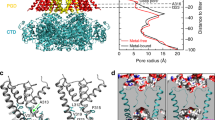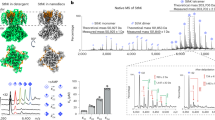Abstract
The energy associated with a mismatch between the hydrocarbon portions of a lipid bilayer and the hydrophobic regions of a transmembrane protein requires that one or both components deform in an attempt to minimize the energy difference. Transmembrane potassium channel subunits are composed of different structural motifs, each responsible for ion-selectivity, conductance and gating capabilities. Each has an inherent degree of flexibility commensurate with its amino acid composition. It is not clear, however, how each structural motif will respond to a fixed amount of distortion applied to the whole structure. We examined the single-channel conductance (Gc) and gating (open probability, P o) of single BKCa channels (hslo α-subunits) inserted into planar lipid bilayers containing 1,2-dioleoyl-3-phosphatidylethanolamine (DOPE) or DOPE with either 1,2-dioleoyl-sn-glycero-3-phosphocholine (DOPC) or sphingomyelin (SPM) and 1-palmitoyl-2-oleoyl-3-phosphatidylethanolamine (POPE) with SPM. These latter three binary mixtures formed stable membranes with different distributions of thickness domains as determined by atomic force microscopy. Channels placed in each composition should be exposed to different amounts of distortion. BKCa channels forced into the DOPE/SPM bilayer containing lipid domains with two different thicknesses showed two distinct levels of Gc and Po. The alterations in Gc and Po were reciprocal. A larger conductance was accompanied by a smaller value for gating and vice versa. Channels forced into the POPE/SPM bilayer containing lipid domains with different thicknesses showed more than two distinct levels of Gc and Po. Channels placed in a uniform bilayer (DOPE/DOPC) showed a uniform distribution of conductance and activation. We conclude that both the inner and outer domains of the channel where these two channel functions are localized respond to deformation and that a fixed amount of distortion results in reciprocal changes in protein function.






Similar content being viewed by others
References
Ahring P.K., Strobaek D., Christophersen P., Olesen S.P., Johansen T.E. 1997. Stable expression of the human large-conductance Ca2+-activated K+ channel. FEBS Lett. 415:67–70
Alvarez O. 1986. How to set up a bilayer system. In: Miller C. (ed). Ion Channel Reconstitution, Plenum Press, New York pp. 115–139
Bell J.E., Miller C. 1984. Effects of phospholipid surface charge on ion conduction in the K+ channel of sarcoplasmic reticulum. Biophys. J. 45:279–287
Bers D.M., Patton C.W., Nuccitelli R. 1994. A practical guide to the preparation of Ca2+ buffers. In: Nuccitelli R. (ed). A Practical Guide to the Study of Calcium in Living Cells, Academic Press, New York pp. 3–29
Bravo-Zehnder M., Orio P., Norambuena A., Wallner M., Meera P., Toro L., Latorre R., Gonzalez A. 2000. Apical sorting of a voltage- and Ca2+-activated K+ channel a-subunit in Madin-Darby canine kidney cells is independent of N-glycosylation. Proc. Natl. Acad. Sci. USA 97:13114–13119
Brown D.A., London E. 2000. Structure and function of sphingolipid- and cholesterol-rich membrane rafts. J. Biol. Chem. 275:17221–17224
Cantor R.S. 1997. The lateral pressure profile in membranes: a physical mechanism of general anesthesia. Biochemistry 36:2339–2344
Cantor R.S. 1999. Lipid composition and the lateral pressure profile in bilayers. Biophys. J. 76:2625–2639
Chu B., Dopico A.M., Lemos J.R., Treistman S.N. 1998. Ethanol potentiation of calcium-activated potassium channels reconstituted into planar lipid bilayers. Mol. Pharmacol. 54:397–406
Corey D.P., Garcia-Anoveros J., Holt J.R., Kwan K.Y., Lin S.Y., Vollrath M.A., Amalfitano A., Cheung E.L., Derfler B.H., Duggan A., Geleoc G.S., Gray P.A., Hoffman M.P., Rehm H.L., Tamasauskas D., Zhang D.S. 2004. TRPA1 is a candidate for the mechanosensitive transduction channel of vertebrate hair cells. Nature 432:723–730
Crowley J.J., Treistman S.N., Dopico A.M. 2003. Cholesterol antagonizes ethanol potentiation of human brain BKCa channels reconstituted into phospholipid bilayers. Mol. Pharmacol. 64:365–372
de Planque M.R., Goormaghtigh E., Greathouse D.V., Koeppe R.E., Kruijtzer J.A., Liskamp R.M., de Kruijff B., Killian J.A. 2001. Sensitivity of single membrane-spanning a-helical peptides to hydrophobic mismatch with a lipid bilayer: Effects on backbone structure, orientation, and extent of membrane incorporation. Biochemistry 40:5000–5010
Doyle D.A. 2004a. Structural changes during ion channel gating. Trends Neurosci. 27:298–302
Doyle D.A. 2004b. Structural themes in ion channels. Eur. Biophys. J. 33:175–179
Doyle D.A., Morais C.J., Pfuetzner R.A., Kuo A., Gulbis J.M., Cohen S.L., Chait B.T., MacKinnon R. 1998. The structure of the potassium channel: Molecular basis of K+ conduction and selectivity. Science 280:69–77
Dufrene Y.F., Lee G.U. 2000. Advances in the characterization of supported lipid films with the atomic force microscope. Biochim. Biophys. Acta 1509:14–41
Duong-Ly K.C., Nanda V., Degrado W.F., Howard K.P. 2005. The conformation of the pore region of the M2 proton channel depends on lipid bilayer environment. Protein Sci. 14:856–861
Fenimore P.W., Frauenfelder H., McMahon B.H., Parak F.G. 2002. Slaving: Solvent fluctuations dominate protein dynamics and functions. Proc. Natl. Acad. Sci. USA 99:16047–16051
Garavaglia M., Dopinto S., Ritter M., Furst J., Saino S., Guizzardi F., Jakab M., Bazzini C., Vezzoli V., Dossena S., Rodighiero S., Sironi C., Botta G., Meyer G., Henderson R., Paulmichl M. 2004. Membrane thickness changes ion-selectivity of channel-proteins. Cell. Physiol. Biochem. 14:231–240
Gillespie P.G., Walker R.G. 2001. Molecular basis of mechanosensory transduction. Nature 413:194–202
Gillis K.D., 2000. Admittance-based measurement of membrane capacitance using the EPC-9 patch-clamp amplifier. Pfluegers Arch. 439:655–664
Giocondi M.C., Boichot S., Plenat T., Le Grimellec C.C. 2004. Structural diversity of sphingomyelin microdomains. Ultramicroscopy 100:135–143
Gribkoff V.K., Starrett J.E., Jr., Dworetzky S.I. 1997. The pharmacology and molecular biology of large-conductance calcium-activated (BK) potassium channels. Adv. Pharmacol. 37:319–348
Horrigan F.T., Heinemann S.H., Hoshi T. 2005. Heme regulates allosteric activation of the Slo1 BK channel. J. Gen. Physiol. 126:7–21
Howard J., Bechstedt S. 2004. Hypothesis: A helix of ankyrin repeats of the NOMPC-TRP ion channel is the gating spring of mechanoreceptors. Curr. Biol. 14:R224–R226
Jakab M., Weiger T.M., Hermann A. 1997. Ethanol activates maxi Ca2+-activated K+ channels of clonal pituitary (GH3) cells. J. Membr. Biol. 157:237–245
Jiang Y., Lee A., Chen J., Cadene M., Chait B.T., MacKinnon R. 2002a. Crystal structure and mechanism of a calcium-gated potassium channel. Nature 417:515–522
Jiang Y., Lee A., Chen J., Cadene M., Chait B.T., MacKinnon R. 2002b. The open pore conformation of potassium channels. Nature 417:523–526
Jiang Y., Pico A., Cadene M., Chait B.T., MacKinnon R. 2001. Structure of the RCK domain from the E. coli K+ channel and demonstration of its presence in the human BK channel. Neuron 29:593–601
Krishnamoorthy G., Shi J., Sept D., Cui J. 2005. The NH2 terminus of RCK1 domain regulates Ca2+-dependent BKCa channel gating. J. Gen. Physiol. 126:227–241
Lagos R., Wilkens M., Vergara C., Cecchi X., Monasterio O. 1993. Microcin E492 forms ion channels in phospholipid bilayer membrane. FEBS Lett. 321:145–148
Lundbaek J.A., Andersen O.S. 1994. Lysophospholipids modulate channel function by altering the mechanical properties of lipid bilayers. J. Gen. Physiol. 104:645–673
Lundbaek J.A., Birn P., Hansen A.J., Sogaard R., Nielsen C., Girshman J., Bruno M.J., Tape S.E., Egebjerg J., Greathouse D.V., Mattice G.L., Koeppe R.E., Andersen O.S. 2004. Regulation of sodium channel function by bilayer elasticity: The importance of hydrophobic coupling. Effects of micelle-forming amphiphiles and cholesterol. J. Gen. Physiol. 123:599–621
MacKinnon R. 2003. Potassium channels. FEBS Lett. 555:62–65
Marrink S.J., Mark A.E. 2004. Molecular view of hexagonal phase formation in phospholipid membranes. Biophys. J. 87:3894–3900
Marsh, D. 1990. Calorimetric data. In: Handbook of Lipid Bilayers, pp. 135–159. CRC Press, Boca Raton, FL
Martens J.R., Navarro-Polanco R., Coppock E.A., Nishiyama A., Parshley L., Grobaski T.D., Tamkun M.M. 2000. Differential targeting of Shaker-like potassium channels to lipid rafts. J. Biol. Chem. 275:7443–7446
Martens J.R., Sakamoto N., Sullivan S.A., Grobaski T.D., Tamkun M.M. 2001. Isoform-specific localization of voltage-gated K+ channels to distinct lipid raft populations. Targeting of Kv1.5 to caveolae. J. Biol. Chem. 276:8409–8414
Maulik P.R., Shipley G.G. 1995. X-ray diffraction and calorimetric study of N-lignoceryl sphingomyelin membranes. Biophys. J. 69:1909–1916
Maxfield F.R. 2002. Plasma membrane microdomains. Curr. Opin. Cell Biol. 14:483–487
Morais-Cabral J.H., Zhou Y., MacKinnon R. 2001. Energetic optimization of ion conduction rate by the K+ selectivity filter. Nature 414:37–42
Nezil F.A., Bloom M. 1992. Combined influence of cholesterol and synthetic amphiphillic peptides upon bilayer thickness in model membranes. Biophys. J. 61:1176–1183
Niu X., Qian X., Magleby K.L. 2004. Linker-gating ring complex as passive spring and Ca2+-dependent machine for a voltage- and Ca2+-activated potassium channel. Neuron 42:745–756
Park J.B., Kim H.J., Ryu P.D., Moczydlowski E. 2003. Effect of phosphatidylserine on unitary conductance and Ba2+ block of the BK Ca2+-activated K+ channel: Re-examination of the surface charge hypothesis. J. Gen. Physiol. 121:375–398
Pietrzykowski A.Z., Martin G.E., Puig S.I., Knott T.K., Lemos J.R., Treistman S.N. 2004. Alcohol tolerance in large-conductance, calcium-activated potassium channels of CNS terminals is intrinsic and includes two components: Decreased ethanol potentiation and decreased channel density. J. Neurosci. 24:8322–8332
Ramu, Y., Xu, Y., Lu, Z. 2006. Enzymatic activation of voltage-gated potassium channels. Nature 442:696–699
Réat V., Patzelt H., Ferrand M., Pfister C., Oesterhelt D., Zaccai G. 1998. Dynamics of different functional parts of bacteriorhodopsin: H-2H labeling and neutron scattering. Proc. Natl. Acad. Sci. USA 95:4970–4975
Rinia H.A., Boots J.W., Rijkers D.T., Kik R.A., Snel M.M., Demel R.A., Killian J.A., van der Eerden J.P., de Kruijff B. 2002. Domain formation in phosphatidylcholine bilayers containing transmembrane peptides: Specific effects of flanking residues. Biochemistry 41:2814–2824
Sun T., Naini A.A., Miller C. 1994. High-level expression and functional reconstitution of Shaker K+ channels. Biochemistry 33:9992–9999
Tombola F., Pathak M.M., Isacoff E.Y. 2005. How far will you go to sense voltage? Neuron 48:719–725
Turnheim K., Gruber J., Wachter C., Ruiz-Gutierrez V. 1999. Membrane phospholipid composition affects function of potassium channels from rabbit colon epithelium. Am. J. Physiol. 277:C83–C90
Valiyaveetil F.I., Zhou Y., MacKinnon R. 2002. Lipids in the structure, folding, and function of the KcsA K+ channel. Biochemistry 41:10771–10777
van den Brink-van der Laan E., Dalbey R.E., Demel R.A., Killian J.A., de Kruijff B. 2001. Effect of nonbilayer lipids on membrane binding and insertion of the catalytic domain of leader peptidase. Biochemistry 40:9677–9684
Venturoli M., Smit B., Sperotto M.M. 2005. Simulation studies of protein-induced bilayer deformations, and lipid-induced protein tilting, on a mesoscopic model for lipid bilayers with embedded proteins. Biophys. J. 88:1778–1798
Vergara C., Latorre R., Marrion N.V., Adelman J.P. 1998. Calcium-activated potassium channels. Curr. Opin. Neurobiol. 8:321–329
Weiss T.M., Van Der Wel P.C., Killian J.A., Koeppe R.E., Huang H.W. 2003. Hydrophobic mismatch between helices and lipid bilayers. Biophys. J. 84:379–385
Williamson I.M., Alvis S.J., East J.M., Lee A.G. 2002. Interactions of phospholipids with the potassium channel KcsA. Biophys. J. 83:2026–2038
Wonderlin W.F., Finkel A., French R.J. 1990. Optimizing planar lipid bilayer single-channel recordings for high resolution with rapid voltage steps. Biophys. J. 58:289–297
Yamashita A., Singh S.K., Kawate T., Jin Y., Gouaux E. 2005. Crystal structure of a bacterial homologue of Na+/Cl–dependent neurotransmitter transporters. Nature 437:215–223
Yang L., Ding L., Huang H.W. 2003. New phases of phospholipids and implications to the membrane fusion problem. Biochemistry 42:6631–6635
Yuan C., Furlong J., Burgos P., Johnston L.J. 2002. The size of lipid rafts: An atomic force microscopy study of ganglioside GM1 domains in sphingomyelin/DOPC/cholesterol membranes. Biophys. J. 82:2526–2535
Yuan C., Johnston L.J. 2001. Atomic force microscopy studies of ganglioside GM1 domains in phosphatidylcholine and phosphatidylcholine/cholesterol bilayers. Biophys. J. 81:1059–1069
Yuan C., Johnston L.J. 2002. Phase evolution in cholesterol/DPPC monolayers: Atomic force microscopy and near field scanning optical microscopy studies. J. Microsc. 205:136–146
Yuan C., O’Connell R.J., Feinberg-Zadek P.L., Johnston L.J., Treistman S.N. 2004. Bilayer thickness modulates the conductance of the BK channel in model membranes. Biophys. J. 86:3620–3633
Zaccai G. 2000. How soft is a protein? A protein dynamics force constant measured by neutron scattering. Science 288:1604–1607
Acknowledgement
We thank Paula Zadek and Andrew Wilson for assistance with growing the HEK-293 cells and John Crowley for helpful discussions and assistance with the preparation of BKCa channels containing membrane fragments from them. Funds were provided by National Institutes of Health grant AA12054 (to S. N. T.).
Author information
Authors and Affiliations
Corresponding author
Rights and permissions
About this article
Cite this article
O’Connell, R.J., Yuan, C., Johnston, L.J. et al. Gating and Conductance Changes in BK Ca Channels in Bilayers Are Reciprocal. J Membrane Biol 213, 143–153 (2006). https://doi.org/10.1007/s00232-006-0034-1
Received:
Revised:
Published:
Issue Date:
DOI: https://doi.org/10.1007/s00232-006-0034-1




